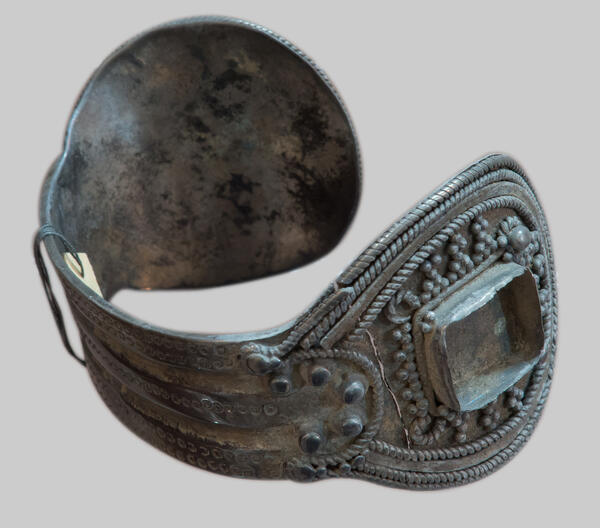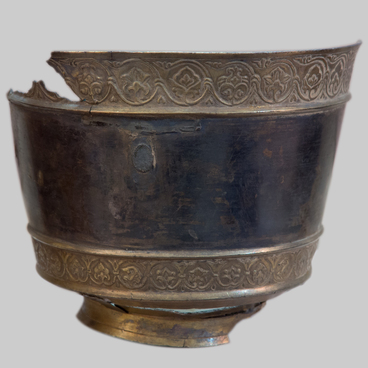Treasures, especially medieval ones, are quite rare. They are usually found by accident when carrying out excavations. In the same way, the ChUpino treasure trove of silver items was found by a local resident near the village of ChUpino during the construction of the Borovsk-Perm highway on August 13, 1959.
A massive flat bracelet from the ChUpino treasure trove is made of silver. The bracelet has two longitudinal grooves; the borders formed by recesses are decorated with ornaments. The rounded flared ends of the bracelet are decorated with belts made of large roll filigree — a pattern of thin silver wire — and granulated with small silver balls. There is a square bezel for inserting stones in the middle of each end blade.
It was believed that the bracelet was made by the masters of the Volga Bulgaria, however, recent archaeological studies have shown that local craftsmen adopted the technique of decorating products with grains and filigree from the Bulgars, their predecessors.
Volga Bulgaria existed in the Middle Volga and Kama regions from the 10th to the 13th century. The state was inhabited by the Bulgarian and other Turkic-speaking tribes, who came in several waves after the collapse of Great Bulgaria, as well as the Kama Finno-Ugrians.
In addition to the bracelet, the treasure trove weighing one kilogram one hundred grams consisted of two twisted torqs — pectorals, as well as a fragment of a silver vessel with floral ornament.
Archaeologists have determined the approximate dating of the treasure trove as XII-XIII centuries. Permyakovskoe and Abramovskoe settlements located in the vicinity of the ChUpino village belong to the same period. Apparently, one of the ancient Permian Komi who lived in these settlements hid a valuable treasure in a moment of danger.
The archive of the museum preserved the minutes of the meeting of the evaluation commission dated August 19, 1959 on the acquisition of a treasure of silver items from the SoyuzExcavation employee the bulldozer operator Veryakin. The text of the minutes reads: ‘Considering that the treasure is of great historical value, we will take the things for the department of history of the pre-revolutionary past and give 500 rubles for the initiative and preservation of the treasure to Comrade Veryakin.’
A massive flat bracelet from the ChUpino treasure trove is made of silver. The bracelet has two longitudinal grooves; the borders formed by recesses are decorated with ornaments. The rounded flared ends of the bracelet are decorated with belts made of large roll filigree — a pattern of thin silver wire — and granulated with small silver balls. There is a square bezel for inserting stones in the middle of each end blade.
It was believed that the bracelet was made by the masters of the Volga Bulgaria, however, recent archaeological studies have shown that local craftsmen adopted the technique of decorating products with grains and filigree from the Bulgars, their predecessors.
Volga Bulgaria existed in the Middle Volga and Kama regions from the 10th to the 13th century. The state was inhabited by the Bulgarian and other Turkic-speaking tribes, who came in several waves after the collapse of Great Bulgaria, as well as the Kama Finno-Ugrians.
In addition to the bracelet, the treasure trove weighing one kilogram one hundred grams consisted of two twisted torqs — pectorals, as well as a fragment of a silver vessel with floral ornament.
Archaeologists have determined the approximate dating of the treasure trove as XII-XIII centuries. Permyakovskoe and Abramovskoe settlements located in the vicinity of the ChUpino village belong to the same period. Apparently, one of the ancient Permian Komi who lived in these settlements hid a valuable treasure in a moment of danger.
The archive of the museum preserved the minutes of the meeting of the evaluation commission dated August 19, 1959 on the acquisition of a treasure of silver items from the SoyuzExcavation employee the bulldozer operator Veryakin. The text of the minutes reads: ‘Considering that the treasure is of great historical value, we will take the things for the department of history of the pre-revolutionary past and give 500 rubles for the initiative and preservation of the treasure to Comrade Veryakin.’



